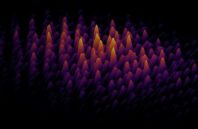Using machine-learning and an integrated photonic chip, researchers from INRS (Canada) and the University of Sussex (UK) can now customize the properties of broadband light sources. Also called “supercontinuum”, these sources are at the core of new imaging technologies and the approach proposed by the researchers will bring further insight into fundamental aspects of light-matter interactions and ultrafast nonlinear optics. The work is published in the journal Nature Communications on November 20, 2018.
In Professor Roberto Morandotti’s laboratory at INRS, researchers were able to create and manipulate intense ultrashort pulse patterns, which are used to generate a broadband optical spectrum. In recent years, the development of laser sources featuring intense and ultrashort laser pulses—that led to the Nobel Prize in Physics in 2018—along with ways to spatially confine and guide light propagation (optical fibre and waveguides) gave rise to optical architectures with immense power. With these new systems, an array of possibilities emerges, such as the generation of supercontinua, i.e extended light spectra generated through intense light-matter interactions.

 (585) 768-2513
(585) 768-2513

